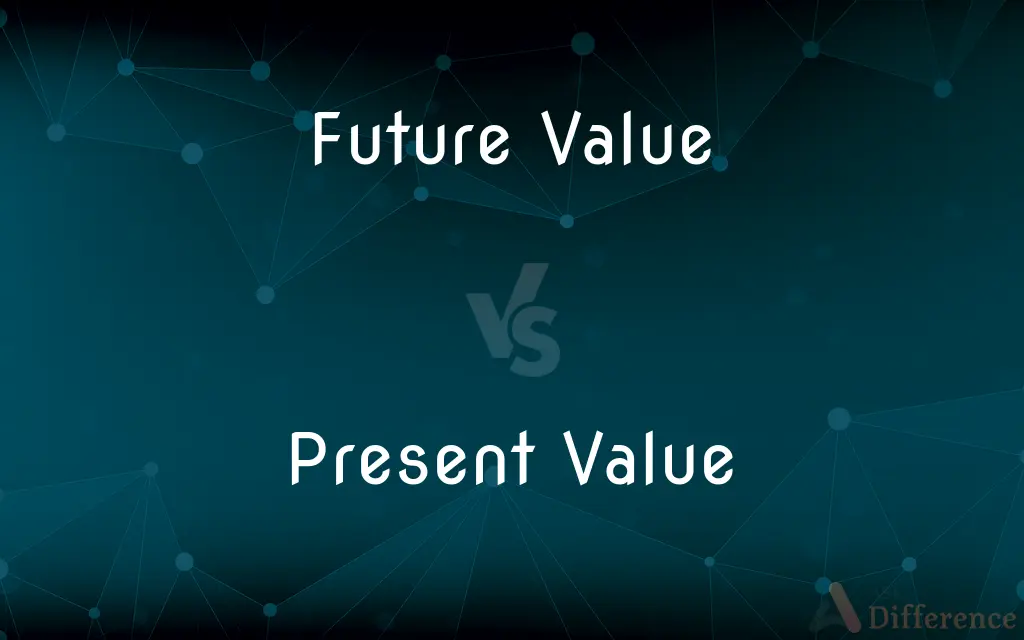Future Value vs. Present Value — What's the Difference?
By Tayyaba Rehman — Published on January 11, 2024
Future Value estimates what an investment grows to over time, while Present Value discounts future cash flows to their value today.

Difference Between Future Value and Present Value
Table of Contents
ADVERTISEMENT
Key Differences
Future Value (FV) represents the amount an investment is worth after a certain period at a specified interest rate, reflecting the growth over time. Present Value (PV) is the current worth of an amount that is expected to be received in the future, discounted by a particular interest rate, representing the current value of future earnings.
FV considers the impact of compounding interest over time, illustrating how much current savings or investments could grow. PV provides insight into how much future cash flows are worth now, helping to determine if investments are worthwhile by comparing the current investment cost to the PV of its future returns.
While Future Value projects the value of current funds at a later date, Present Value translates future money into today’s dollars, aiding in accurately comparing financial choices. FV calculations assume a certain rate of return, while PV calculations work to find out the equivalent value of future cash today, given a specific rate of discount or interest.
Future Value is critical for setting investment goals, as it helps investors understand potential returns. Conversely, Present Value helps in making decisions about the value of investments, loans, or other financial instruments in present terms.
Future Value helps in assessing the potential success of long-term financial plans, showing the maturity value of securities. Present Value helps investors and financial managers understand the minimum amount they should invest today to reach a desired financial target in the future.
ADVERTISEMENT
Comparison Chart
Time Value of Money
Value at a future date
Value at the current date
Calculation Focus
Growth over time
Current worth of future cash
Interest Impact
Compounded
Discounted
Investment Decision
What future savings could amount to
What future returns are worth today
Financial Planning
Used for projecting returns
Used for assessing investment value
Compare with Definitions
Future Value
Estimation of investment growth over time.
Calculating the Future Value helps in understanding the potential appreciation of our investments.
Present Value
Current equivalent of a future sum of money.
The Present Value of next year's $1,000 revenue is less due to the time value of money.
Future Value
Projection of present money's worth in the future.
Her 401(k) plan's Future Value is expected to be substantial enough to ensure a comfortable retirement.
Present Value
Determines what future money is worth today.
In finance, Present Value calculations are critical for evaluating long-term investment returns.
Future Value
Determines the maturity amount of current investments.
The bond's Future Value is important for investors looking for fixed-income securities.
Present Value
Discounted value of future cash flows.
She calculated the Present Value of her winnings to be lower than the jackpot's nominal value.
Future Value
Financial concept used in saving and investment strategies.
Financial advisors often use Future Value to encourage clients to invest early.
Present Value
Assesses the immediate value of future payments.
The Present Value of the lease payments determined whether the property investment was worthwhile.
Future Value
Value of current assets at a specified future date considering interest.
The Future Value of our savings account will be $10,000 in five years with compound interest.
Present Value
Helps in comparing the value of money received at different times.
Present Value helps to decide if it's better to receive $100 now or in a year.
Common Curiosities
Why is Future Value important?
It’s important for planning investment goals over a period.
How is Present Value used in finance?
It's used to determine the current value of future cash flows.
What role does compounding play in Future Value?
Compounding increases FV by applying interest on interest earned.
Can Future Value fluctuate with interest rates?
Yes, FV is sensitive to changes in interest rates.
What does Future Value tell an investor?
It tells how much current investments will be worth in the future.
What does a higher Present Value indicate?
It indicates greater worth of future cash in today's terms.
In what scenario is Future Value most relevant?
When saving for long-term goals like retirement or education.
How does inflation affect Present Value?
PV accounts for inflation by discounting future cash flows.
Does Present Value assume money has time value?
Yes, it's based on the principle that money now is worth more than the same amount later.
How does Present Value affect investment decisions?
It helps determine if an investment's future returns are worth the cost today.
Why might Present Value be considered more complex?
It requires understanding discount rates and time value of money.
Is Future Value applicable to all types of investments?
Yes, FV can be calculated for any investment given the interest rate and time.
What formula is used for Present Value?
PV = FV / (1 + i)^n, adjusting future value for the time value of money.
How do you calculate Future Value?
FV is calculated using the formula FV = PV × (1 + i)^n, where i is the interest rate and n is the number of periods.
Is Future Value more optimistic than Present Value?
It can be seen as more optimistic as it reflects potential growth without accounting for current opportunity costs.
Share Your Discovery

Previous Comparison
Disguisedness vs. Disguise
Next Comparison
Combat Controller vs. TACPAuthor Spotlight
Written by
Tayyaba RehmanTayyaba Rehman is a distinguished writer, currently serving as a primary contributor to askdifference.com. As a researcher in semantics and etymology, Tayyaba's passion for the complexity of languages and their distinctions has found a perfect home on the platform. Tayyaba delves into the intricacies of language, distinguishing between commonly confused words and phrases, thereby providing clarity for readers worldwide.














































